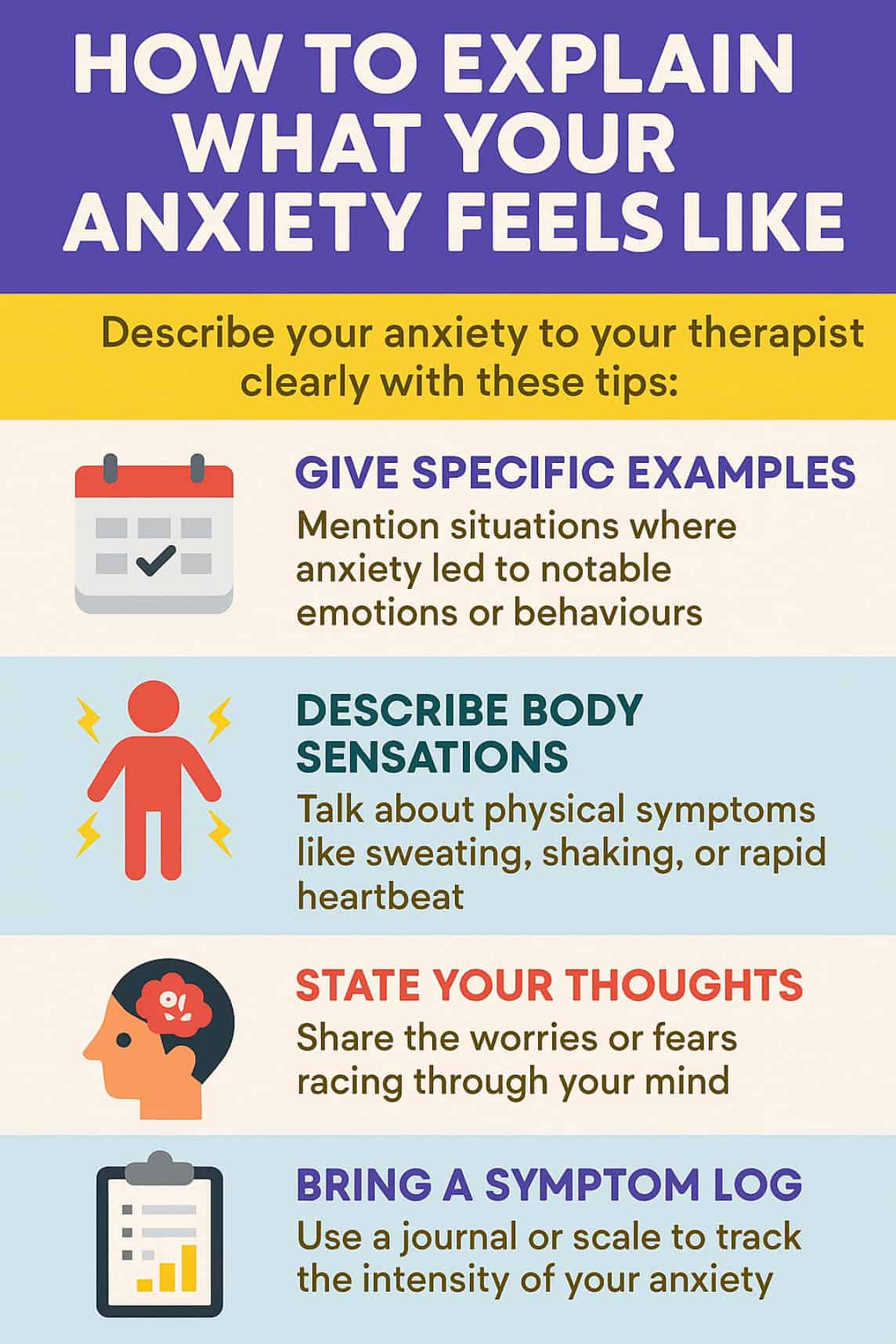
Key Takeaways for Explainung What My Anxiety Feels Like.
- Describe physical symptoms like a racing heart, tight chest, or nausea.
- Share your anxious thoughts, even if they seem irrational or embarrassing.
- Talk about your behaviours, including how you cope (e.g., avoiding situations or using substances).
- Use specific examples from daily life to give context.
- Bring a symptom log or rating scale (if possible) to help track patterns and triggers over time.
Clear communication helps your therapist personalise your treatment and support your progress more effectively.
👉 Ready to take the next step? learn more about anxiety therapy at AERCS and book your free 15-minute phone consultation.

To explain what your anxiety feels like to your therapist, describe specific examples of when anxiety shows up in your life, break it down into what you feel in your body, what thoughts run through your mind, and how you behave or respond, including if you turn to substances or avoid certain situations. This honest, clear explanation helps your therapist understand exactly how anxiety affects you so they can tailor your treatment plan effectively.
Why It’s So Important to Explain Your Anxiety Clearly.
Many people across Orangeville, Toronto and the GTA begin anxiety therapy unsure of how to put their experiences into words. You might worry that your description will sound irrational, dramatic, or just hard to understand. But the better you can explain what your anxiety feels like, the more quickly your therapist can offer strategies that actually work for your unique situation.
According to the Canadian Mental Health Association, anxiety disorders are among the most common mental health problems in the country, affecting nearly 5% of the population at any given time. And yet, no two people experience anxiety the same way, which is why your personal input matters so much.
Break It Down: Body, Thoughts, and Behaviour.
1. Describe Physical Sensations.
When anxiety hits, how does your body react? Common sensations include:
- Tightness in your chest.
- Racing heartbeat.
- Upset stomach.
- Sweaty palms.
- Dizziness or feeling lightheaded.
Say something like, “I feel like I can’t take a full breath when I walk into a meeting,” or “My hands shake when I have to make a phone call.” These specific examples help your therapist recognise patterns and triggers.
2. Share the Thoughts That Spiral.
What kinds of thoughts loop through your mind when anxiety strikes?
- “Everyone’s judging me”.
- “What if I mess this up?”
- “I’ll never get through this”.
Even if the thoughts feel embarrassing or irrational, they are valuable insight for your therapist. You’re not being judged, they’ve heard many different thoughts and are trained to help you work with these thoughts, not avoid them.
3. Note Your Behaviours and Reactions.
Do you avoid situations, cancel plans, or reach for substances when you’re anxious?
Examples:
- You skip work events because your chest tightens in social settings.
- You use alcohol or cannabis to calm down before bed.
- You procrastinate on tasks that trigger anxious thoughts.
Include these behaviours, even if they feel like coping mechanisms. Your therapist needs the full picture to offer the right tools.
Use Real-Life Examples to Add Context.
Rather than saying “I feel anxious all the time,” say:
- “When I have to meet my boss, I feel nauseous and my mind goes blank”.
- “I cancelled a dentist appointment last week because I was afraid I’d panic in the chair”.
- “I felt my anxiety climbing when I couldn’t find parking, and I ended up leaving the grocery store”.
These real-life scenarios give your therapist a clearer view of how anxiety affects your day-to-day life. It also helps highlight your progress later, when you return to those situations with more control.
Try Using a Symptom Log or Rating Scale.
You don’t need to remember everything on the spot. Keep a short daily or weekly log that tracks:
- When your anxiety occurred.
- What triggered it.
- How intense it felt (on a scale of 1 to 10).
- What you thought or did in response.
This doesn’t have to be fancy. A few notes in your phone or a small journal are enough to give your therapist information they can use to adjust your treatment.
There are also tools like the GAD-7 questionnaire (Generalized Anxiety Disorder assessment) that some therapists use. If they don’t bring it up, you can ask to use something similar if you wish.
What If You Struggle to Describe It?
Don’t worry if you freeze up during your first few sessions. This is common. You can say:
- “I’m not sure how to describe it, but I’ll try.”
- “It’s like a feeling of dread in my chest that comes out of nowhere.”
- “Sometimes I just feel like something bad is about to happen.”
You can also bring in metaphors. Some people say their anxiety feels like:
- A constant buzzing.
- A tight rope around their lungs.
- A fog that clouds their thinking.
- A pit of fear in their stomach.
There’s no “wrong way” to describe your experience. The important thing is to speak from your truth.
Why Clarity Helps Your Therapist Help You.
The more clearly you explain what your anxiety feels like, the easier it is for your therapist to:
- Identify triggers.
- Track patterns.
- Introduce effective tools like CBT, breathing exercises, or exposure therapy.
- Know when to refer you for other supports, such as medication.
The more you share, the more they can personalise your care.
Your Next Step.
If you’ve been wondering how to explain what your anxiety feels like to your therapist, just remember to keep it simple and real: describe the physical feelings, the thoughts that show up, and what you do in response. Add examples, write it down if needed, and be as honest as you can. Your therapist is there to help, not to judge.
Click here to learn more about Anxiety Therapy and how to book your free 15-minute consultation. You don’t have to face anxiety alone. Let’s talk about it, together.
How do I explain what my anxiety feels like to my therapist if I don’t know the words?
Use everyday examples, describe body reactions like a racing heart or tight chest, and try using metaphors. Your therapist can help you fill in the gaps.
Should I explain what my anxiety feels like even if it sounds irrational?
Yes. Your thoughts help your therapist understand your triggers and thinking patterns so they can better help with your treatment.
Can I explain what my anxiety feels like by writing it down?
Absolutely. Journals or symptom logs are great tools to explain what your anxiety feels like when speaking out loud feels difficult.
Why is it important to explain what my anxiety feels like early in therapy?
Clear communication from the start helps your therapist target the right techniques, making therapy more effective from day one.
What should I avoid when trying to explain what my anxiety feels like?
Try to avoid vague phrases like “I feel bad” without details. Instead, describe physical symptoms, thoughts, or real-life examples of anxious moments.
Do You Need Anxiety Therapy?
Take this quick self-assessment to see if anxiety therapy could help you manage symptoms.Note: This questionnaire is educational only and does not replace a clinical assessment. If you wish to obtain professional guidance, please follow up with a licensed mental health professional.

